BUICK RIVIERA 1993 Owners Manual
Manufacturer: BUICK, Model Year: 1993, Model line: RIVIERA, Model: BUICK RIVIERA 1993Pages: 324, PDF Size: 16.01 MB
Page 211 of 324
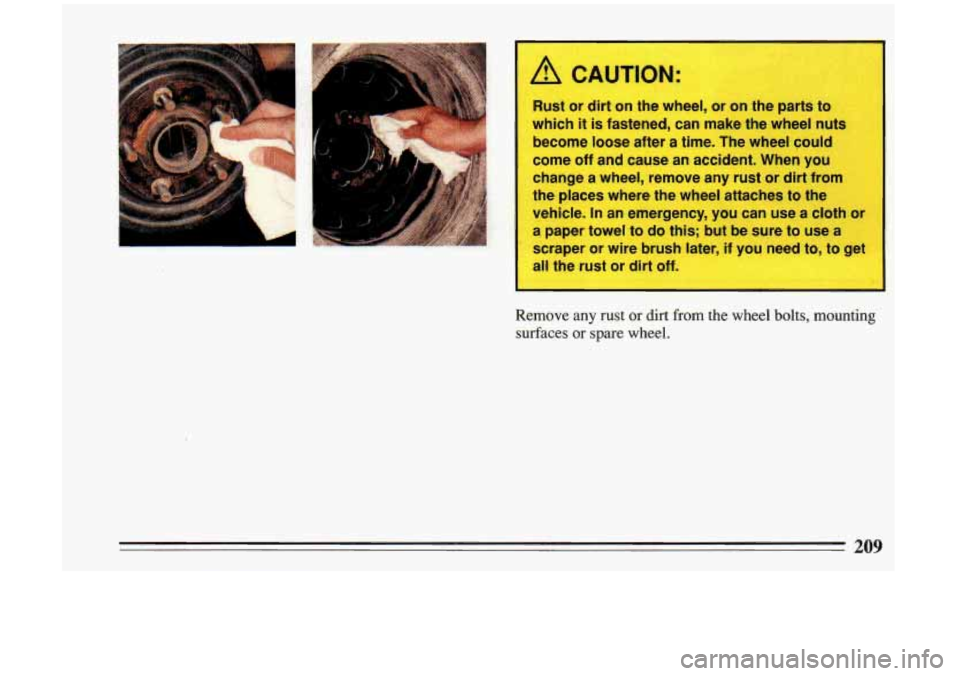
A CAUTION:
Rust or dirt on the wheel, or on the parts to
which it
is fastened, can make the wheel nuts
become loose after
a time. The wheel could
come off and cause an accident. When you
change a wheel, remove any rust or dirt from
the places where the wheel attaches to the
vehicle.
In an emergency, you can use a cloth or
a paper towel to do this; but be sure to use a
scraper or wire brush later, if you need to, to get
all the rust or dirt off.
Remove any rust or dirt from the wheel bolts, mounting
surfaces or spare wheel.
Page 212 of 324
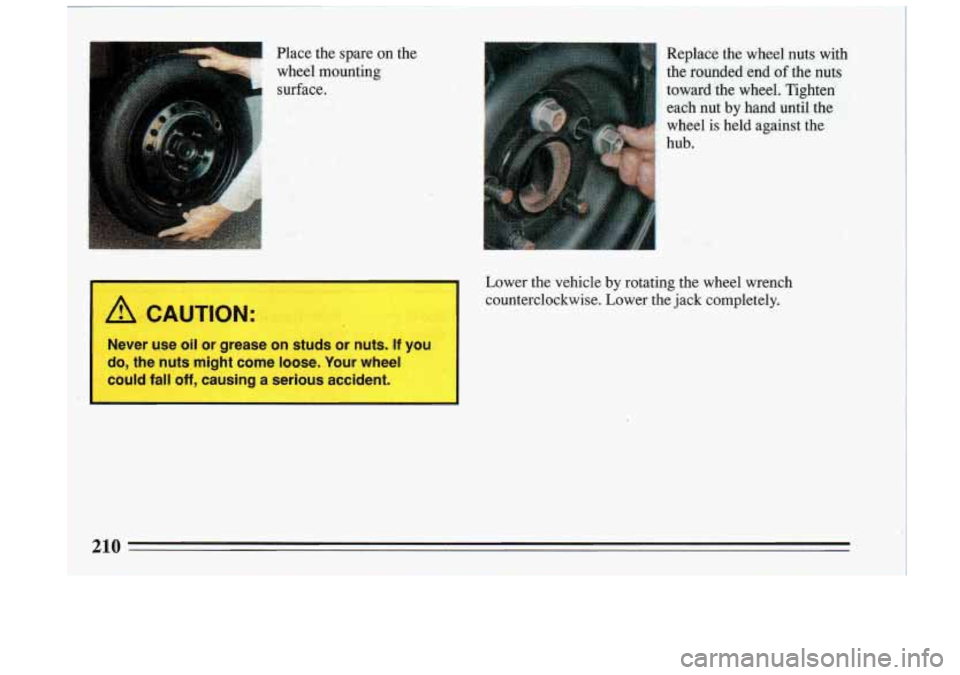
I Place the spare on the
wheel
.mounting
surface.
' Replace the wheel nuts with
the rounded-end of the nuts
toward the wheel. Tighten'
each nut by hand
until the
wheel
is held against the ' -
hub.
, counterclockwise. Lower the jack completely.
Lower the vehicle
by rotating the wheel wrench
/r CAUTIO'N:
Never use ail or grease on studs 1 nuts. If you
d,o, the nuts might !corne l~oose. Your w,heel
muld fall 'off, causing a serious accident.
Page 213 of 324
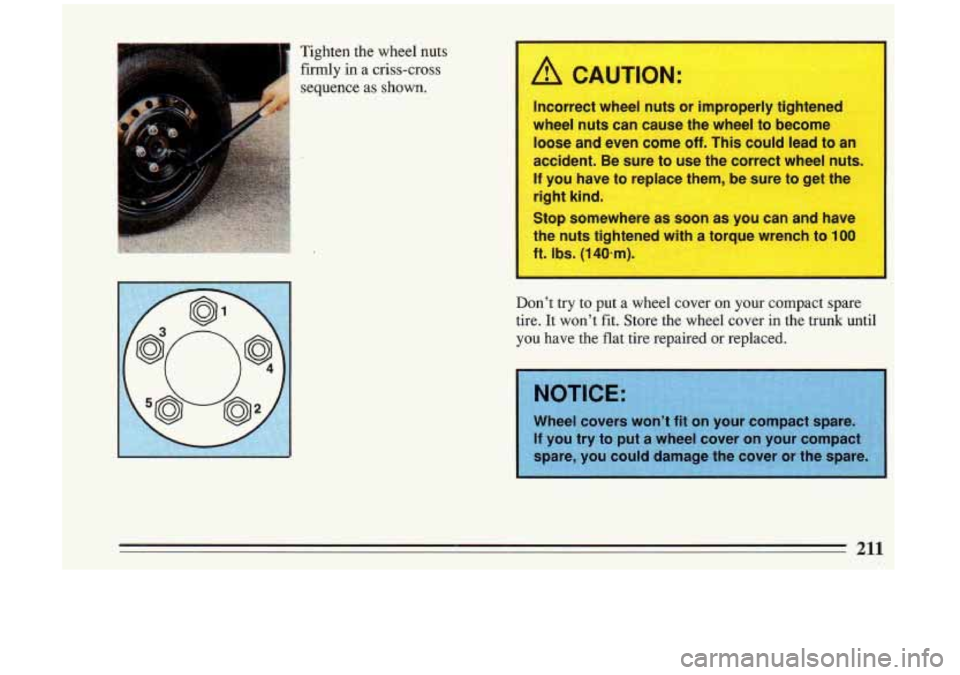
Tighten the wheel nuts
firmly in a criss-cross
sequence as
shown. A CAUTION:
Incorrect wheel nuts or improperly tightened
wheel nuts can cause the wheel to become
loose and even come
off. This could lead to an
accident. Be sure to use the correct wheel nuts.
If you have to replace them, be sure to get the
right kind.
Stop somewhere as soon as you can and have
the nuts tightened with a torque wrench to
100
ft. Ibs. (140.m).
Don't try to put a wheel cover on your compact spare
tire. It won't fit. Store the.whee1 cover
in the trunk until
you have the flat tire repaired
or replaced.
Page 214 of 324
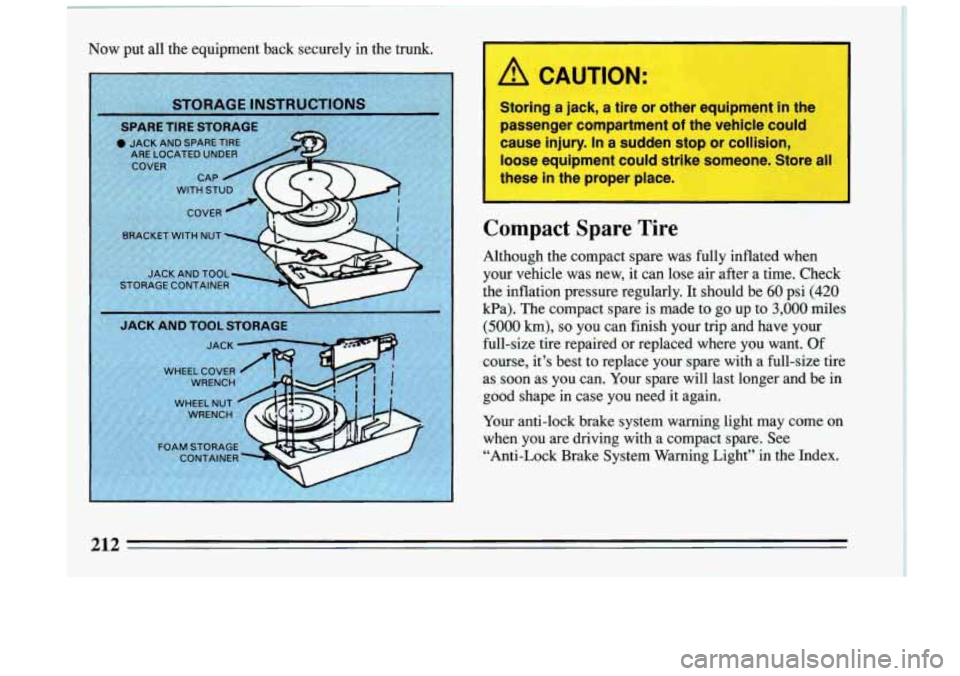
Now put all the equipment back securely in the trunk.
Compact Spare Tire
Although the compact spare was fully inflated when
your vehicle was new, it can lose air after a time. Check
the inflation pressure regularly. It should be
60 psi (420
kPa). The compact spare is made to go up to 3,000 miles
(5000 km), so you can finish your trip and have your
full-size tire repaired or replaced where you want.
Of
course, it’s best to replace your spare with a full-size ti\
re
as soon as you can. Your spare will last longer and be in
good shape in case you need it again.
Your anti-lock brake system warning light may come on
when you are driving with a compact spare. See
“Anti-Lock Brake System Warning Light” in the Index.
212
Page 215 of 324
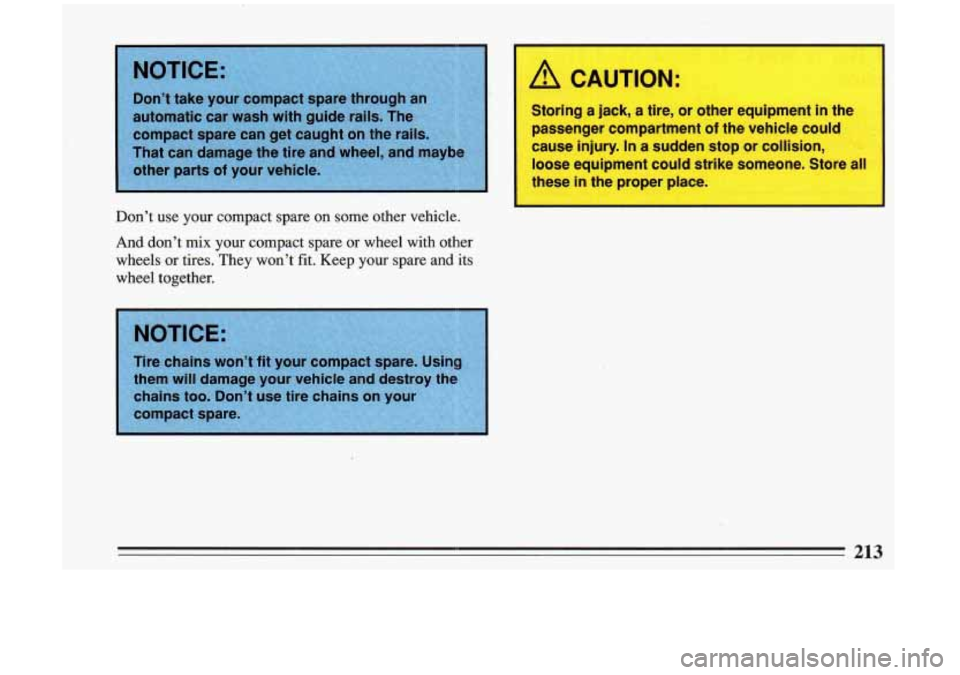
Don’t use your compact spare on some other vehicle.
And don’t mix^ your compact spare or wheel with other
wheels or tires. They won’t fit. Keep your spare
and its
wheel together.
A CAUTION:
Storing a jack, a tire, or other equipment in the
passenger compartment
of the vehicle could
cause injury. In a sudden .stop or collision,
loose equipment could strike someone. Store all
these in the proper place.
213
Page 216 of 324
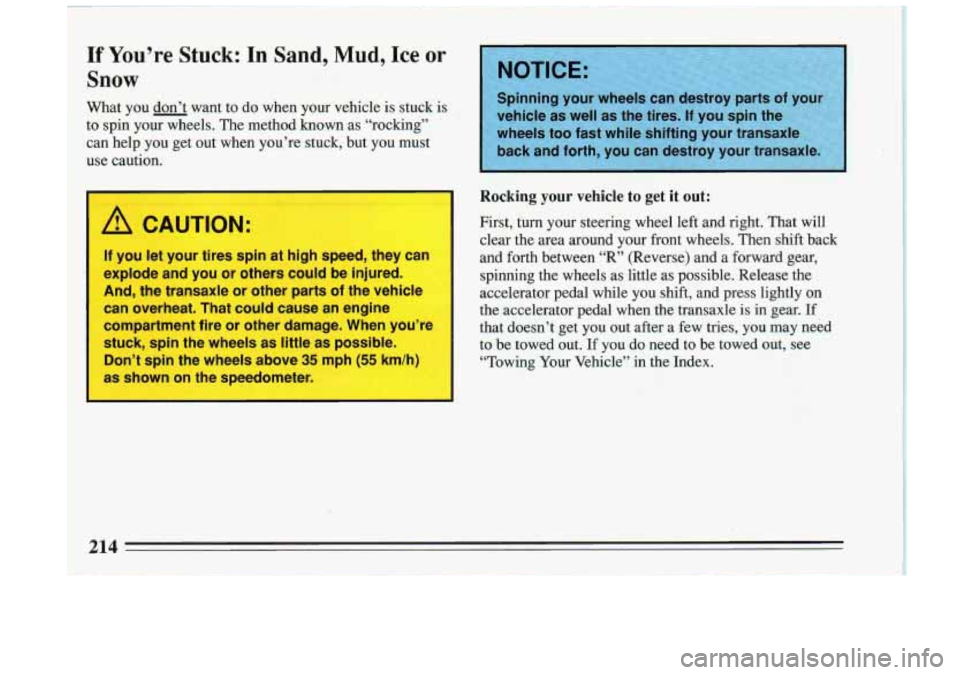
L I
If You’re Stuck: In Sand, Mud, Ice or
Snow
What you don’t want to do when your vehicle is stuck is
to spin your wheels. The method known
as “rocking”
can help
you get out when you’re stuck, but you must
use caution.
A CAUTION:
If you let your tires spin at high speed, they can
explode and you or others could be injured.
And, the transaxle or other parts of the vehicle
can overheat. That could cause an engine
compartment fire or other damage. When you’re
stuck, spin the wheels as little as possible.
Don’t spin the wheels above
35 mph (55 km/h)
as shown on the speedometer.
Page 217 of 324
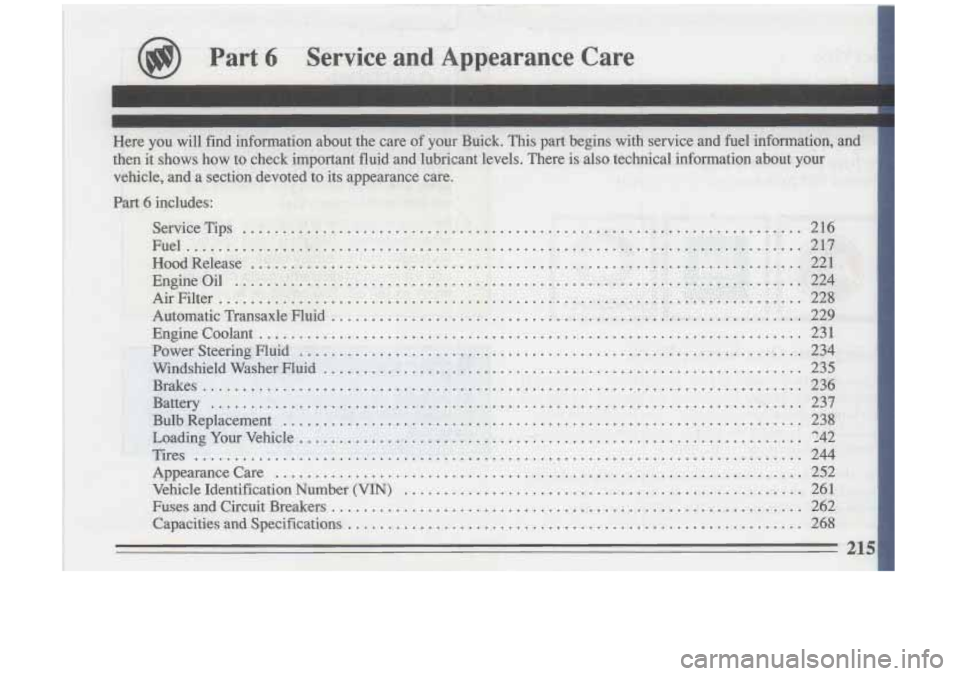
I
, 1
................................... .~. .................... -21.
1
................. a
fiel.. ... * ....... ,. .I.. ...................................... ;,. .,.,. ........... i.:. . .:. ..... zLv,
Page 218 of 324
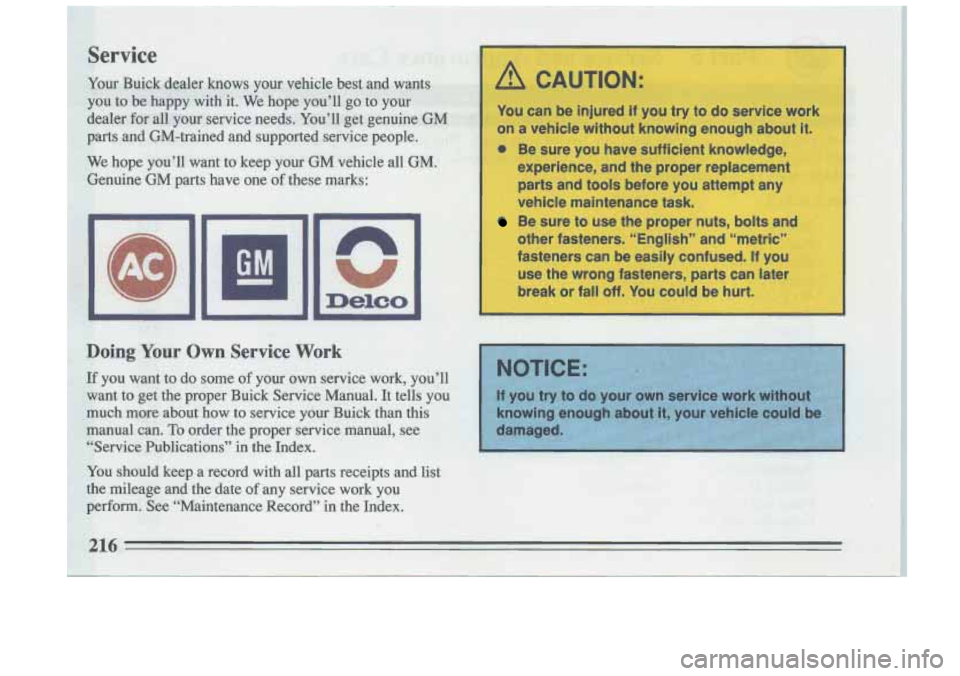
A CAUTION: I
You can be injured if you try to do service work
on a vehicle without knowing enough about
it. I
@ Be sure you have sufficient knowledge,
experience, and the proper replacement
parts and tools before you attempt any
Be sure to use the proper nuts, bolts and
other fasteners. "English" and "metric"
fasteners can be easily confused.
If you
use the wrong fasteners, parts
can later
break or fall
off. You could be hurt. $$g?$&$
~~~
vehicle maintenance task. gg@b%j.g ,;.. ,F!(7>>p I &. @fijy+; &~-*.,~<+@ %,.,!+:<$$
"Vil
."C.L.. .
Page 219 of 324
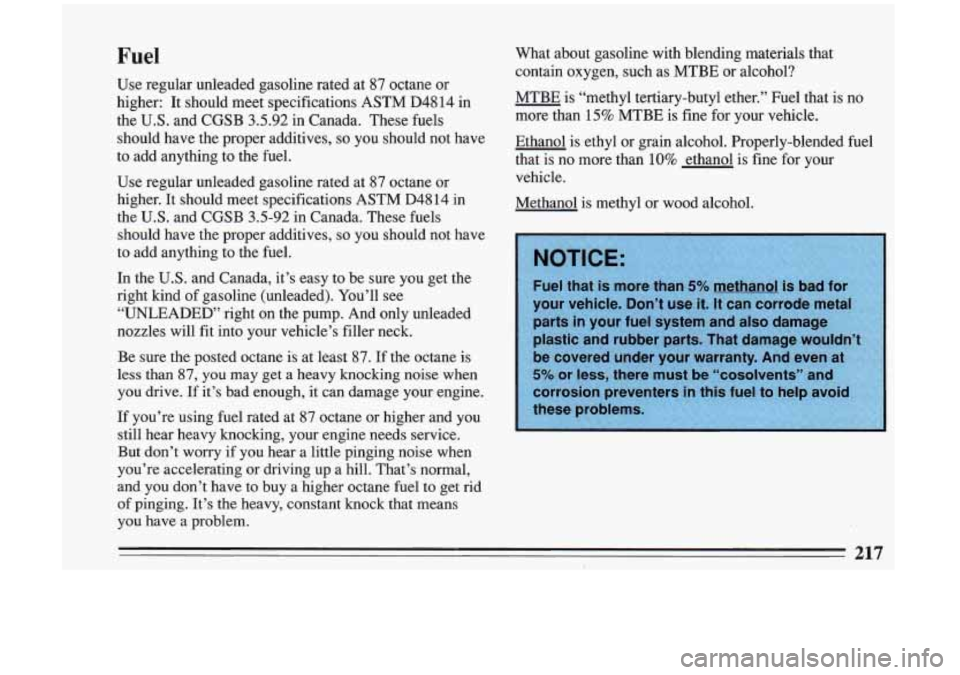
Fuel
Use regular unleaded gasoline rated at 87 octane or
higher: It should meet specifications ASTM D4814 in
the U.S. and CGSB 3.5.92 in Canada. These fuels
should have the proper additives,
so you should not have
to add anything to the fuel.
Use regular unleaded gasoline rated at 87 octane or
higher. It should meet specifications ASTM D4814 in
the U.S. and CGSB 3.5-92 in Canada. These fuels should have the proper additives,
so you should not have
to add anything to the
fuel.
In the U.S. and Canada, it’s easy to be sure you get the
right kind of gasoline (unleaded). You’ll see
“UNLEADED” right on the pump. And only unleaded
nozzles will fit into your vehicle’s filler neck.
Be sure the posted octane
is at least 87. If the octane is
less than
87, you may get a heavy knocking noise when
you drive. If it’s bad enough,
it can damage your engine.
If you’re using fuel rated at 87 octane or higher and you
still hear heavy knocking, your engine needs service.
But don’t worry if you hear a little pinging noise when
you’re accelerating or driving up a hill. That’s normal,
and you don’t have to buy a higher octane fuel to get rid
of pinging. It’s the heavy, constant knock that means
you have a problem. What about gasoline with blending materials that
contain oxygen, such as MTBE or alcohol?
MTBE is “methyl tertiary-butyl ether.” Fuel that is no
more than 15% MTBE is fine for your vehicle.
Ethanol
is ethyl or grain alcohol. Properly-blended fuel
that is no more than
10% ethanol is fine for your
vehicle.
Methanol is methyl or wood alcohol.
217
Page 220 of 324
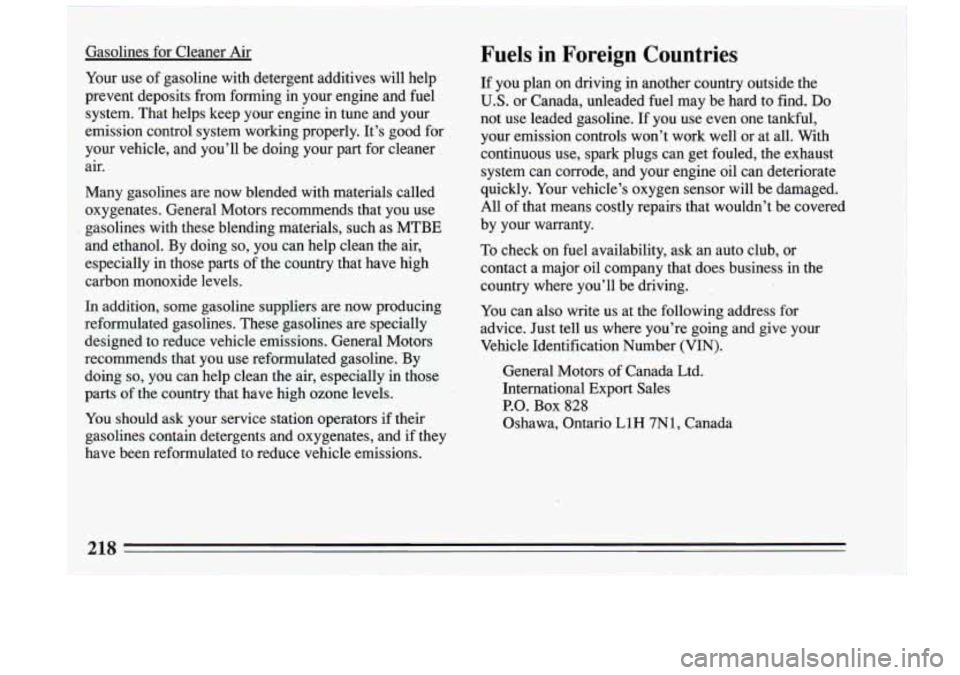
I
Gasolines for Cleaner Air
Your use of gasoline with detergent additives will help
prevent deposits from forming in your engine and fuel
system. That helps keep your engine in tune and your
emission control system working properly. It’s good €or
your vehicle, and you’ll be doing your part for cleaner
air.
Many gasolines are now blended with materials called oxygenates. General Motors recommends that you use
gasolines with these blending materials, such as MTBE
and ethanol. By doing
so, you can help clean the air,
especially in those parts
of the country that have high
carbon monoxide levels.
In addition, some gasoline suppliers are now producing
reformulated gasolines. These gasolines are specially
designed to reduce vehicle emissions. General Motors
recommends that you use reformulated gasoline. By
doing
so, you can help clean the air, especially in those
parts of the country that have high Ozone levels.
You should ask your service station operators if their
gasolines contain detergents and oxygenates, and if they
have been reformulated
to reduce vehicle emissions.
Fuels in Foreign Countries
If you plan on driving in another country outside the
U.S. or Canada, unleaded fuel may be hard to find. Do
not use leaded gasoline. If you use even one tankful,
your emission controls won’t work well or at all. With
continuous use, spark plugs can get fouled, the exhaust system can corrode, and your engine oil can deteriorate
quickly. Your vehicle’s oxygen sensor will be damaged.
All of that means costly repairs that wouldn’t be covered
by your warranty.
To check on fuel availability, ask an auto club, or
contact a major oil company that does business in the
country where you’ll be driving.
You can also write us at the following address for
advice. Just tell us where you’re going and give your
Vehicle Identification Number
(VIN).
General Motors of Canada Ltd.
International Export Sales
P.O. Box 828
Oshawa, Ontario L1H 7N1, Canada
218